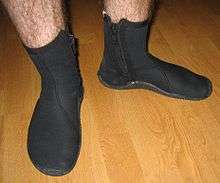Wetsuit boots

In water sports a bootee, bootie, or wetsuit boot is a thick sock-like garment made of wetsuit material. They protect the diver's feet when walking out of water, with or without a wetsuit, and keep the feet warm under water.
Bootee functions
Thermal skin
In many water sports such as scuba diving, surfing, kayaking, windsurfing, sailing and even fishing, bootees are worn to keep the feet warm in the same way that a wetsuit would. The neoprene material is impervious to water and acts as a skin of insulation trapping the wearer's body heat.
Bootee thickness is proportional to how much heat insulation it provides and thus to how cold the water which the user can tolerate; it may be above or below the standard of 5–6 mm of neoprene. In warmer climates where the thermal qualities of the bootee are not so important, a bootee with a thickness of 2-3.5 mm is common.
The leg of the bootee may have a zipper down one side or may be tightened with a velcro strap at the front of the bootee. Where a bootee is worn with a wetsuit it is normally tucked into the leg of the wetsuit to minimise the loss of body heat and to keep foreign objects out.
Foot protection
A bootee usually has a reinforced sole for walking. Typically, this is a rubber compound that is thicker and tougher than the neoprene used for the upper part of the bootee but is still flexible. The reinforced sole provides the wearer with some protection when walking across shingle, coral and other sharp objects.
For scuba diving
For scuba diving the sole of the bootee should not be so thick that the diver cannot get a diver's fin on over it. Divers wearing bootees usually need fins with a foot part larger than with bare feet. Some manufacturers make bootees with soles reinforced with rubber hobnails which can not be worn with fins and were likely intended for wading. Divers in warm water who do not wear a diving suit sometimes wear bootees so they can wear bigger fins.
Diving bootees are typically only intended for wear with open-heeled fins (with a buckle) and usually do not fit into full-footed fins. Much thinner neoprene socks are sometimes used with full-footed fins, but more for the purpose of preventing chafing and blisters, than for warmth.
For surfing
For surfing (and also windsurfing, kitesurfing and other such sports) bootees are typically worn where the weather is so cold that the surfer would lose some degree of functionality in his feet. The bootee should be thin enough that it can be worn with the leg of a wetsuit pulled over it. Another concern is that the bootee should not restrict the ability of the surfer to grip the board with the toes in the desired manner. Split toe bootees allow for some further functionality in this respect.
Reef walkers are small bootees that are only as high as the ankle and generally are only between 2 and 3.5mm thick. These bootees are designed to allow surfers to get out to waves that break at coral reefs or at rocky beaches.
For kayaking
Several styles of wetsuit boots are commonly used for kayaking. Short-cut wetsuit booties are frequently used in warmer conditions where the boots help give grip and foot protection while launching. In the colder months it is common to see longer wetsuit boots used with a drysuit where they are worn over the rubber drysuit socks.